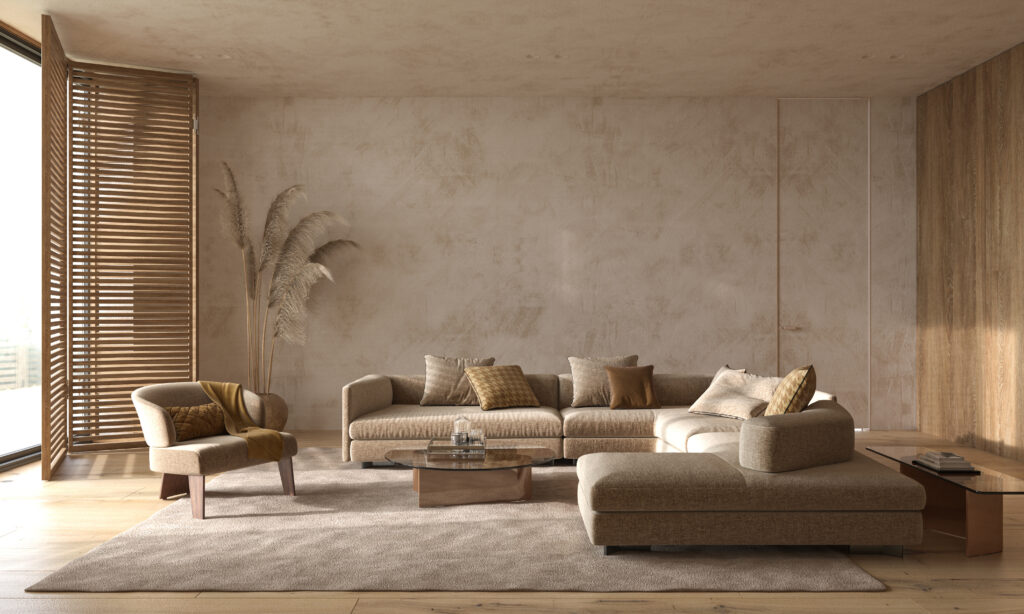
Decorating a home extends way beyond simply making it appear ‘presentable and aesthetic.’ It is about creating a space that reflects certain values and evokes certain feelings.
In fact, homes are meant to be a tranquil sanctuary where the interior resonates and speaks to who you truly are — and among the multiple different design styles, the Japandi Style is one such approach that makes sure you achieve that feeling of peace and perfection.
So continue scrolling as we go on to discover the top 13 ways to incorporate Japandi Style into your home
What Is Japandi Style?
Japandi style is a beautiful blend of two themes: Scandinavian and Japanese. By fusing together the smooth, clean lines of Scandi interiors with the functionality and elegance of Japanese design, the Japandi style creates minimalist yet welcoming and practical spaces.
Both designs share the same core principles of simplicity and efficiency, the hybrid Japandi style results in a seamless mix of minimalism, natural elements, and a soft color palette.
Keep Things Simple
At the core of the Japandi style lies simplicity. A minimalist aesthetic in pared-down colors determines the interior. So, for every design choice made, keep things simple. From streamlined furniture to soothing color palettes, maintain your focus on decorating the home around solid, clean shapes and raw, organic forms.
Cut Down on Clutter
The Japandi design style emphasizes the concept of less is more.
As simple as it sounds, decluttering the interior is a great starting point to transform a room into a Japandi interior. Get rid of unnecessary things, prioritize functional pieces, and resist the urge to stock up on chunky furniture items. Make sure to include only the things that have a purpose.
Stick to the Japandi Color Scheme
Scandinavian and Japanese share a love of neutral, toned-down hues, so the Japandi color scheme is naturally inclined towards earthy neutrals. A good rule of thumb is to stick to three colors when decorating a Japandi interior. Choose hues from muted tones, like beige, white, grey, and taupe, to showcase a calm and cozy vibe. Black, greens, and browns will do great as accents — thanks to their nature-inspired feel that mimics Japandi’s admiration for nature.
Embrace Sustainability
The Japandi style is more than just creating a beautiful space. It focuses on reflecting the beauty of nature — and protecting its allure by making sustainable choices when decorating. Hemp, rattan, bamboo, cane, cotton, and wood are all popular choices for a Japandi style.
When outfitting the interior, these sustainable and striking materials can contribute to a well-thought-out, dynamic look. The best part? Every decor element, from flooring and furniture to window treatments, wall art, and accent pieces, can be found in natural, eco-friendly materials.
Keep it Well-Lit & Airy
A sense of serenity can be achieved in the interior by keeping it well-lit and airy. Big windows with light coverings in delicate hues bring beautiful views from the surroundings and allow an efficient exchange of fresh air. Top this effect with lightweight fabrics and minimal, sleek-line furniture to avoid blocking the natural light and the revitalizing breeze from flowing freely.
Upgrading the lighting will also help reveal the cozy yet serene vibe of the style. Ditch a heavy chandelier with an organically shaped ceiling light. For an open floor plan, think of something like a multiple-light fixture paired with your favorite Japandi-style floor lamps and pendant lights for a dynamic look.
Go Green
The Japandi design takes plants as its best friend. The explanation lies in the harmonic feeling created by the organic plant shapes of varieties like Bonsai, Kokedama, Rubber Tree, and Peace Lily. To balance the Japanese and Scandinavian practice of relying on plants to uplift moods, plant your favorite Japandi greens in light-colored planters, like beige, white, or cream.
Highlight Craftsmanship
Connected to the wabi-sabi design, appreciating the beauty of hand-crafted items is an important element of the Japandi style. A pottery planter, for example, that isn’t a perfect circle can be included in the decor as a unique piece that grabs attention.
In general, any items made of natural materials (like wood or clay) with imperfections, valuing the progression of time and link to nature, can be a part of the Japandi style. Whether it’s hand-painted tiles from a local store or a handwoven hammock chair, every piece contributes to making your home one-of-a-kind.
Layer Cozy Textures
What’s the simplest way to transform a basic room into a Japandi design? Layer cozy textures! Why? The Scandinavian design gets its warm feel from soft blankets and fluffy pillows, while the Japanese design makes the most of sustainable living by relying on natural materials like bamboo. By layering different textures, the fusion decor Japandi aesthetic nods to both styles while creating a tasteful interior.
Join Circles with Squares
Don’t be afraid to combine Scandi’s curves with the Japanese design’s straight lines. One of our favorite ideas is to add sofas with sharp lines and accessorize them with spherical cushions. The right angles bring discipline, while the circular shapes introduce a sense of movement — both working together to showcase richness in the Japandi design.
Experiment with Color Contrast
Does the Japandi style allow color contrast? Absolutely. Though the design style focuses on a laid-back color scheme, it also welcomes playful contrasts of different shades. The key is to keep the color divergence subtle.
Instead of opting for an entirely black accent wall, for example, add pops of the shade here and there. Think a cream backdrop with a set of black and beige wall decor. Accessories like cushion covers, throws, lampshades, and rugs are other interesting places that can be leveraged to introduce contrasting shades.
Stripped Furniture
Japandi interiors keep the decor and color scheme minimal and inject interest through visually appealing furniture pieces, like stripped furniture, ribbed side tables, and textured light fixtures. Keeping in mind the Japandi belief of attaining peace and serenity through closeness to the Earth, the furniture items are kept low-profile, near the floor.
For the material, Scandi uses Mahagony, Oak, and Teak, while the Japanese prefer Chestnut (Kuri), Keyaki (Zelkova), and Cypress (Hinoki). You can incorporate both materials to create stunning contrasts between the lighter and darker shades of wood.
Fluted designs, like a wooden slat wall, are another way to create a head-turning statement without overpowering the space. Thin, vertical wood stripes made of bamboo or cedar are great for crafting architectural interest — and providing soundproofing!
Incorporate Japanese Design Elements
Japanese design elements bring life to the Japandi aesthetic. They create a sense of harmony and balance that gives an inviting aura to the space. Some popular aspects to consider are;
- Shoji (sliding doors) to allow in maximum natural light.
- Shizen (the use of natural materials) to embrace sustainable living.
- Tatami (mats) to naturally regulate the humidity levels.
Clean lines and warm textiles from the Scandi design will add the perfect touch to the harmonious spaces featured by Japandi homes.
Play Around with Decor Arrangements
Symmetry isn’t an essential requirement for a Japandi-themed room. In fact, Funkinsei (asymmetry) — being a part of the Japanese design — is formally included in Japandi interiors. This gives designers the freedom to play around with different furniture pieces for a more organic look. For example, you can pair a statement sofa with a bold accent chair.
However, keep the visual weight of every item in consideration. Prioritize balancing above over-decorating.
Final words
Japandi design is the best style feature to create a serene ambiance and a functional design with toned-down aesthetics. Tip: Remember to always follow your heart when decorating — even if it means personalizing some of the Japandi principles






Greetings! This is my first comment here so I just wanted to give a
quick shout out and say I truly enjoy reading through your blog posts.
Can you recommend any other blogs/websites/forums that cover the same subjects?
Thank you!
Hello
Thank you so much for the feedback, it’s very much appreciated.
I recommend you take a look at:
– Studio Mcgee
– Jenna sue design co.
– Porche and co
– Grace in my space
Thank you